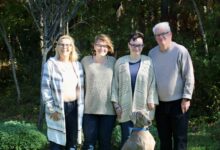What the HHT?
A blog for the HHT community
Blog
Press Release: Cure HHT Plays Key Role in First Successful HHT Trial

For more than 30 years, Cure HHT has helped to expand the research and medical community focusing on HHT.
We’re thrilled to share some important news from the world of HHT research.
The National Institutes of Health-sponsored PATH trial is complete, the results are in, and it marks an important step forward for HHT treatment and care. This trial was the first positive, large-scale randomized trial for an HHT therapeutic. This study tested the use of the cancer drug pomalidomide in treatment of HHT-related bleeding — and researchers saw very promising results. The data was strong enough that the trial ended early!
But the news gets even better: Now, the full results of the study are published in the New England Journal of Medicine (you can read it here) — one of the most prestigious medical publications in the world, read by more than one million physicians every week. This is a huge win for HHT Awareness, as this publication puts HHT in the spotlight of the medical community.
At Cure HHT, we are the catalyst for driving HHT science forward. We’re proud to have played an important role in advocating for the funding necessary to run this study, and in recruitment to ensure its success.
Read our full press release here and learn more about this milestone below.
Read MoreHHT Kids Day – San Francisco
Do you live near San Francisco? We have an event for you! HHT Kids Day, co-hosted by UCSF HHT Center of Excellence and Cure HHT at the California Academy of Sciences Museum promises to be an amazing day of learning and fun! Did we mention it’s FREE! It’s a great way to meet HHT families in your area, share experiences, and learn more about HHT from the experts at UCSF. Space is limited. Learn more and register today!
Read MoreUplifting Athletes Support the Rare Disease Community
What does the NFL Draft, WWE star Joe Spivak (aka Tank Ledger), and HHT research have in common? Before Feb 2024, nothing! Allow me to explain this improbable connection and introduce you to another rare disease advocacy organization called Uplifting Athletes.
Cure HHT’s draft pick was Dr. Anthony Anzell. The Uplifting Athletes scientific advisory board carefully reviewed applications and grant proposals from all researchers and we were very pleased when Dr. Anzell was selected to represent HHT and receive funding to support his work. Dr. Anzell is an HHT patient himself and after receiving his doctorate, he began studying HHT as a postdoctoral scholar. Anthony was diagnosed at age 15 after multiple trips to the emergency room with horrible migraines. It took a courageous and bold mother to advocate for her son and finally he received scans that showed his brain was covered in abscess, his liver was also infected, and he had many pulmonary AVMs. After three brain surgeries, a liver surgery, and embolization of all the vessel malformations in his lungs, Anthony squeaked out alive. I wouldn’t say he was unphased because he healed and began doing crazy endurance events like ultra marathons, ironman races, and incredibly long swims all in the name of HHT awareness. Now, in addition to running for awareness, he is chasing a cure for HHT through research.
Read MoreAn HHT patient conference can change your life
A Letter from Cure HHT Board Member, Jim Lapides
I am writing to share an invaluable opportunity for all HHT patients – Cure HHT is hosting its national patient conference. I say “invaluable opportunity” because going to my first patient conference in 2012 saved my life.
I was in crisis; laser treatments no longer worked for me, and I could not control my bleeds. My wife and I went to the conference armed with notebooks and learned as much as we could at the sessions. We talked with as many doctors, fellow patients, Cure HHT staff, board members and center directors as we could to learn about potential solutions today and in the future. I went home with a short- and long-term game plan – deciding on the best treatments and the right team to guide me. It led to a new procedure that worked for me and then a second treatment that worked even better. And it led me to finding an HHT Center of Excellence “home base” as well as expert clinicians at other HHT Centers and beyond that have helped me avoid problems and treat new ones.
Read MoreAnn Trussell: “My promise to my daughters…I will do everything in my power to find a cure!”
Ann Trussell joined the Cure HHT Board of Directors to help ensure the next generation of HHT patients don’t experience the pain and struggles of generations past.
“My promise to my daughters is that as long as I’m able, I will do everything in my power to find a cure,” Ann says. “Children are being born with HHT every day. We owe it to them to do better!”
For Ann and her family, as is all too common with HHT, so many signs and symptoms were overlooked for years. A diagnosis didn’t come until her youngest daughter, Lauren, was born.
Lauren suffered a stroke in utero, and doctors were never able to pinpoint why. As she got older, Lauren began passing out and turning blue. Again, no one seemed to know why. One day when Lauren was 9 years old, it happened and “she wasn’t coming back to us,” Ann remembers. Lauren was taken to Children’s Hospital of Philadelphia’s cardiac care floor where a chest CT would reveal a massive AVM in Lauren’s right lung. Dr. Scott Trerotola, Director of the HHT Center of Excellence at UPenn, was called to review the scans.
Read More




